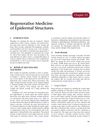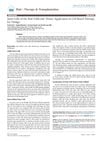Search
forProducts matching "epidermal cell transplants"
Tracking 1 products like 123 Polaris minoxidil shampoo NR02 from by companies like Minoxidil Express. View product »Learn
4 / 4 resultslearn Osteopontin
signaling protein that, when suppressed, may grow hair by reducing inflammation and stem cell loss
learn Thymosin Beta 4
learn Low Level Laser Therapy
laser therapy for anti-inflammatory and likely insignificant hair regrowth effects
Research
5 / 1000+ results
research Regenerative Medicine of Epidermal Structures
New treatments for skin and hair repair show promise, but further improvements are needed.

research Stem Cells of the Hair Follicular Tissue: Application in Cell-Based Therapy for Vitiligo
Hair follicle stem cells could be used to treat the skin condition vitiligo.
research Rejuvenation of Aged Pig Facial Skin by Transplanting Allogeneic Granulocyte Colony-Stimulating Factor-Induced Peripheral Blood Stem Cells from a Young Pig
Injecting young pig stem cells can make old pig skin look younger and more elastic.
research Hair Regeneration Methods Using Cells Derived From Human Hair Follicles and Challenges to Overcome
Current hair regeneration methods show promise but face challenges in maintaining cell effectiveness and creating the right environment for hair growth.

research Pathogenesis and Regenerative Therapy in Vitiligo and Alopecia Areata: Focus on Hair Follicle
Hair follicles are key to treating vitiligo and alopecia areata, but challenges exist.
Community Join
5 / 81 resultscommunity How all hormones affect our hair follicles. Not just DHT. Take a look at this paper. Prolactin, melatonin, cortisol, progesterone, testosterone and more
The conversation discusses various factors affecting hair loss, not just DHT, and mentions treatments like Minoxidil, finasteride, and melatonin. Some users report personal experiences with these treatments and hormone tests, while others speculate on the role of hormones like prolactin and cortisol in hair loss.
community Clearing the air on how non-surgical treatments really work
Treatments for hair loss, including finasteride, dutasteride, minoxidil, ketoconazole, microneedling, and low level laser light therapy, which aim to reduce DHT production, increase cell absorption and blood flow, and stimulate epidermal stem cells. It also stresses the importance of patience when using these treatments.
community The end of balding: We may have just found the secret to hair regrowth
MCL-1 is important for hair follicle stem cell survival, but its impact on human hair regrowth is unclear. Minoxidil and finasteride are the main treatments, with doubts about new discoveries leading to effective human solutions soon.
community PP405: The Ultimate Hair Loss Drug for Complete Hair Growth
PP405 is a new hair loss treatment in phase 2 trials that may promote hair growth by increasing lactate production and activating hair follicle stem cells. It could potentially replace hormone-disrupting treatments like Minoxidil and finasteride.

community If You Have DUPA, PLEASE READ THIS: Everyone Should Be Scalp Biopsied
Scalp biopsies are crucial for diagnosing hair loss conditions like Diffuse Unpatterned Alopecia (DUPA) and retrograde hair loss, as treatments like finasteride and dutasteride may not be effective if other conditions are present. Combining PPAR-GAMMA agonists with retinoids could improve treatments for conditions like Lichen Planopilaris.